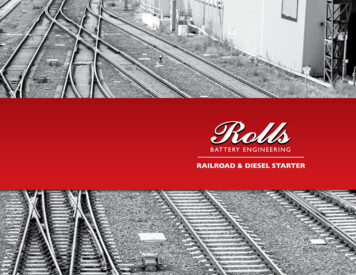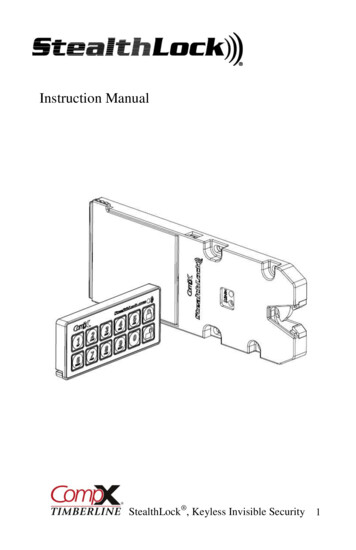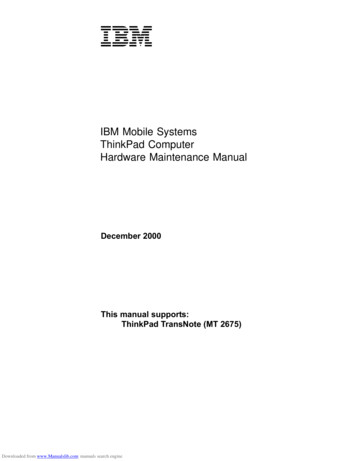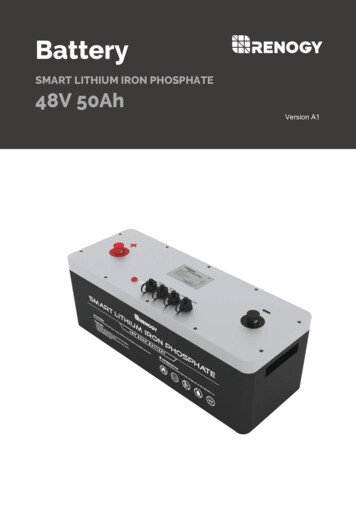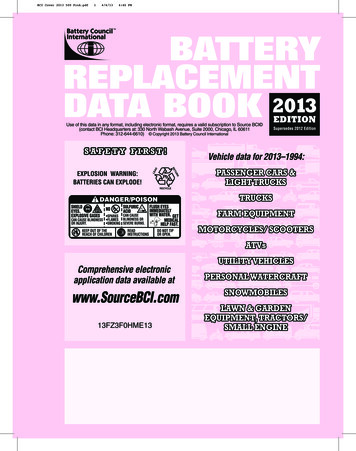
Transcription
BCI Cover 2013 509 Pink.pdf14/4/134:46 PM
2013 BATTERY REPLACEMENT DATA BOOKCOLD CRANKING PERFORMANCE @ 0 F is a rating used to describe battery highrate discharge capability atlow temperature. It is the discharge load in amperes that a new, fully charged battery at 0 F (–18 C) can continuouslydeliver for 30 seconds and maintain a terminal voltage equal to or higher than 1.20 volts per cell. This is the batteryrating listed under the heading CCA (0 F) recommended by MOST vehicle manufacturers for use on eachvehicle listed in this book. Sometimes a battery may have to provide power for ignition and lighting in the event offailure in the vehicle's electricity generating system. The following definition defines this capability:RESERVE CAPACITY is defined as the number of minutes which a new, fully charged battery at 80 F (27 C) can becontinuously discharged at 25 amperes and maintain a terminal voltage equal to or higher than 1.75 volts per cell.PERFORMANCE RANGES listed in the tables of pages 11 through 14 are suggested, based on battery performancesnormally available. They are provided as a reference only, and are not intended to cover all batteries produced.EXPLOSION WARNINGSDANGERSHIELDEYESEXPLOSIVEGASES CAN CAUSEBLINDNESS OR INURYNOSULFURICACID SPARKS FLAMES SMOKINGCAN CAUSEBLINDNESS ORSEVERE BURNSFLUSH EYESIMMEDIATELYWITH WATERGETMEDICALHELPFASTKEEP OUT OF THE REACH OF CHILDREN DO NOT TIP KEEP VENT CAPS TIGHT AND LEVELEXPLOSIVEGASESPOISONCAUSESSEVERE BURNSCigarettes, flames, or sparks could causebattery to explode. Always shield eyes andface from battery. Do not charge or usebooster cables or adjust post connectionswithout proper instruction and training.KEEP VENT CAPS TIGHT AND LEVELContains sulfuric acid. Avoid contact withskin, eyes, or clothing. In event of accidentflush with water and call a physicianimmediately.KEEP OUT OF REACH OF CHILDRENBoth the graphic and the written messages are in compliance with Rule #16 CFR Part 1500, for use on lead-acidbatteries and acid packages under 5 gallons. Either may be used at the discretion of the manufacturer or distributor.HEAT SHIELD — CAUTIONProtective heat shields around batteries are being used with increasing frequency to protect the battery from very highunder-hood temperatures. Failure to replace the heat shield after installation of a replacement battery may reduce itselectrical performance and/or life.OLD MODEL VEHICLES — WARNINGRecommendations in this data book assume that modifications affecting battery position have not been made to avehicle. To avoid possible injury and damage, installers should check that the terminals do not touch compartmentwalls, holddowns, trays, heat shields, or other metal objects when the hood compartment is closed.DISCLAIMERThe replacement battery information in this data book has been obtained from the equipment manufacturers listed,except as otherwise noted. Users are cautioned that the information in this book was the most current informationprovided to BCI at the time of publication. However, the information is subject to change upon notice from equipmentmanufacturers or field experience. Therefore, users should use the most current edition of the Battery Replacement DataBook. The Battery Council International and its members, hereafter called BCI, expressly deny any responsibility for theaccuracy of the information provided to BCI. While BCI has made every effort to accurately catalog the replacementbattery information in this book, BCI disclaims any warranties, expressed or implied, for its accuracy. BCI also denies anyliability for damages as a consequence of using the information in this book. Users should also attempt to obtainreplacement battery information from the equipment manufacturer’s user manual or service department for their specificapplication.BEST-FIT ESTIMATESome equipment manufacturers do not provide complete replacement battery information to BCI. BCI estimates areplacement battery size to give some guidance to the Battery Replacement Data Book user. However, the user iscautioned that the size stated is an estimate only, and the user should obtain specific replacement battery sizeinformation from the equipment manufacturers.COLD CRANKING PERFORMANCE @ 0 F RATINGS IN APPLICATION SECTIONThe Cold Cranking Performance ratings listed in the application section of the text, unless otherwise noted, are thoseof the O.E. or O.E.S. battery(s) provided in each motor vehicle. THERE IS NO WARRANTY LEVEL OR BATTERY LIFEEXPECTANCY EXPRESSED OR IMPLIED BY THESE VALUES. Copyright 2013 Battery Council International2Printed in U.S.A.
2013 BATTERY REPLACEMENT DATA BOOKCONTENTSPAGESExplosion Danger, Installation, Charging, Handling, Booster Cables . 2-5Explanation of Data, Abbreviations . 6BCI Assembly Numbers, Cell Layouts, Holddowns and Polarity . 7-11BCI Group Numbers, Dimensional Specifications and Ratings . 12-15BCI/DIN/EN Reference Chart . 16BCI/JIS Reference Chart . . 17Power Sport Battery Type Reference and Terminals Charts. 18-21APPLICATION SECTIONPassenger Cars and Light Trucks . 22-50Trucks . 51-63Farm Equipment . 64-70Lawn & Garden Equipment / Small Engine . 71-85POWERSPORT – Motorcycle & Scooter .86-93POWERSPORT – Utility Vehicle .94POWERSPORT – ATV .95-98POWERSPORT – Personal Water Craft / Snowmobile / Go-Kart .98-103Part Applications Footnotes .1043
SAFETY FIRSTDANGERSHIELDEYESEXPLOSIVEGASES CAN CAUSEBLINDNESS OR INURYNOSULFURICACID SPARKS FLAMES SMOKINGCAN CAUSEBLINDNESS ORSEVERE BURNSFLUSH EYESIMMEDIATELYWITH WATERGETMEDICALHELPFASTKEEP OUT OF THE REACH OF CHILDREN DO NOT TIP KEEP VENT CAPS TIGHT AND LEVELEXPLOSIVEGASESPOISONCAUSESSEVERE BURNSCigarettes, flames or sparks could causebattery to explode. Always shield eyes andface from battery. Do not charge or usebooster cables or adjust post connectionswithout proper instruction and training.KEEP VENT CAPS TIGHT AND LEVELContains sulfuric acid. Avoid contact withskin, eyes or clothing. In event of accidentflush with water and call a physicianimmediately.KEEP OUT OF REACH OF CHILDRENDANGER OF EXPLODING BATTERIESBatteries contain sulfuric acid and produce explosive mixtures of hydrogen and oxygen. Because self-discharge actiongenerates hydrogen gas even when the battery is not in operation, make sure batteries are stored and worked on ina well-ventilated area. ALWAYS wear safety glasses and a face shield when working on or near batteries. When working with batteries:* Always wear proper eye, face, and hand protection.* Keep all sparks, flames, and cigarettes away from the battery.* Do not remove or damage vent caps.* Make sure work area is well ventilated.* Never lean over battery while boosting, testing, or charging.SAFE BATTERY INSTALLATIONTo assure safe installation and proper operation, follow these installation procedures:* Disconnect ground cable first (this is usually the negative cable; however, older vehicles may have a positiveground).* Remove battery — note position of positive ( ) and negative (–) terminals. Mark the cables for correct connectionto replacement battery.* Clean terminals and cable connections with a wire brush. Broken connections and frayed or cut cables should bereplaced.* Install the replacement battery in the same position as the old one. Secure battery with the holddownassembly.* Make sure the terminals do not touch any metal mounting, engine, or body parts.* Connect cables tightly. Connect ground cable last to avoid sparks.SAFE CHARGINGBefore beginning the charging operation, read the instructions that come with the charger. Never attempt to charge abattery without first reviewing the instructions for the charger being used. In addition to the charger manufacturer’sinstructions, these general precautions should be followed:* Always charge batteries in a well-ventilated area and wear proper eye protection.* Turn the charger and timer ‘‘OFF’’ before connecting the leads to the battery to avoid dangerous sparks.* Never try to charge a visibly damaged or frozen battery.* Connect the charger leads to the battery; red positive ( ) lead to the positive ( ) terminal and black negative (–)lead to the negative (–) terminal. If the battery is still in the vehicle, connect the negative lead to the engine blockto serve as a ground. (If the vehicle is positive grounded, connect the positive lead to the engine block.)* Make sure that the leads to the connections are tight.* Set the timer, turn the charger on, and slowly increase the charging rate until the desired ampere value isreached.* If the battery becomes hot or if violent gassing or spewing of electrolyte occurs, reduce the charging rate ortemporarily discontinue the charge.* Always turn the charger ‘‘OFF’’ before removing charger leads from the battery to avoid dangerous sparks.4
2013 EDITIONSAFETY FIRSTSAFE HANDLING OF BATTERY ACIDBattery acid, or electrolyte, is a solution of sulfuric acid and water that can destroy clothing and burn the skin. Useextreme caution when handling electrolyte and keep an acid-neutralizing solution — such as baking soda orhousehold ammonia mixed with water — readily available. When handling battery acid:* Always wear proper eye, face, and hand protection.* If the electrolyte is splashed into an eye, immediately force the eye open and flood it with clean, cool water for atleast 15 minutes. Get prompt medical attention.* If electrolyte is taken internally, drink large quantities of water or milk. DO NOT induce vomiting. Call a physicianimmediately.* Neutralize any electrolyte that spills on a vehicle or in the work area with baking soda. After neutralizing, rinsethe contaminated area clean with water.To prepare electrolyte of a desired specific gravity, always pour the concentrated acid slowly into the water; DO NOTpour water into the acid. Always stir the water while adding small amounts of acid. If noticeable heat develops, allowthe solution to cool before continuing to add acid.CALIFORNIA PROPOSITION 65 WARNING***Batteries, battery posts, terminals and related accessories contain lead and lead compounds, chemicals known tothe State of California to cause cancer and reproductive harm.Batteries also contain other chemicals known to the State of California to cause cancer.WASH HANDS AFTER HANDLING!5
EXPLANATION OF DATAThe Data Book is intended to assist the battery aftermarket in the orderly marketing of batteries, for which there is a substantial demand.Batteries are classified into numbered Group Sizes according to their voltage, maximum overall dimensions, terminal arrangement, and specialfeatures that affect battery fit.BCI GROUP NUMBERS, DIMENSIONAL SPECIFICATIONS AND RATINGSCurrent BCI Group Size Numbers are defined in the tables on pages 12 through 17. The approximate Cold Cranking Performance Range represents the battery performances commonly available in the aftermarket. Each Group Size is listed once and is classified according to the prevailingreplacement application for batteries in that Group Size. To determine the correct battery for purchase and installation, refer to the Cold CrankingPerformance shown for the specific make, model, or year listed in the application section.BCI ASSEMBLY NUMBERS, CELL LAYOUTS, HOLDDOWNS, AND TERMINALSNumbered sketches (Assembly Figure Numbers) shown under this heading, on pages 7 through 9, illustrate the various terminal arrangements andseveral typical terminal designs.APPLICATION SECTIONThis section lists the Group Size and Cold Cranking (CCA) Performance ratings of the Original Equipment battery or batteries provided in eachmotor vehicle listed. Where Original Equipment (O.E.) CCA is not available, Original Equipment Service (O.E.S.) will be used.Thee application information is shown under the following categories:Passenger Cars and Light TrucksLawn & Garden TractorsTrucksPOWERSPORT - MotorcycleFarm EquipmentPOWERSPORT - Utility VehiclePOWERSPORT - ATVPOWERSPORT - Personal WatercraftPOWERSPORT - SnowmobileThere is 20-year coverage given for Passenger Cars, Light Trucks & Vans, 25-year coverage for Truck and Farm Equipment and 30-year coverage for PowerSport and Lawn & Garden Equipment.How to use the Application SectionThe manufacturers are arranged alphabetically and an APPLICATION SECTION index is listed on page 3. For Passenger Cars, Light Trucks & Vans,the applications are listed by year and engine size, whereas the remaining vehicles and equipment are listed by model and/or engine numbers. Youshould determine the following facts in order to assure the proper replacement battery:1 — Locate the desired manufacturer.2 — Determine the year and/or model.3 — Select the correct model or engine.4 — Read across for the BCI Group Number and Original Equipment Cold Cranking Performance.Whenever a battery Group Number is followed by another Group Number, this indicates a substitute battery, not an exact replacement for theOriginal Equipment battery. This substitute information is listed only with the approval of the vehicle manufacturer.Example: 24 or 24FWhen more than one battery is required, this is indicated by the number in parentheses following the Group Number.Example: 31T(2), 31T(3), 31T(4)Regarding the terms ‘‘Optional’’ and ‘‘All optional’’Example: 2011 V8 5.0L .58Optional .65V8 5.8L .65All optional .65540650650850The Group Number 58 with a 540 Cold Cranking Performance is standard equipment on the V8 5.0L. Group 65 with a 650 Cold CrankingPerformance is available as an option on the V-8 5.0L and as standard equipment on the V8 5.8L. Group 65 with a 850 Cold Cranking Performanceis available as an option on all engines listed under the year 1990.Note: The fact that an optional battery is listed for a particular vehicle does not guarantee that the vehicle will accept the option. For example: The1990 vehicle listed above could come from the factory with a battery tray large enough only for a Group 58 or it could have a tray which would accepteither a Group 58 or a Group 65. Please observe and carefully note all footnote DINDOHCEFIENETR6-Air Conditioning-Allis-Chalmers-Absorbed Glass Mat-Amp-hour-Ampere-Altitude-Automatic Transmission-All Terrain Vehicle-Battery Council llar-cubic centimeter-Cold Cranking Amps (0 F)-Central Fuel inuously Variable Transmission-cylinder-Detroit Diesel-Direct Electric Start-Deutsche Industrie Normen-Dual Overhead Cam-Electronic Fuel Injection-European Norm-Electronic Tuning c-engine-except-Federal-Figure-Fuel Injection-Florida-Front-Wheel Drive-generator-General Motors-Gas Starting Engine-Heated Back Light(rear window defrost)-Heavy Duty-High Output-Horsepower-High Swirl Combustion-Heated Windshield-International Harvester Co.-industrial-Japanese Industrial Standard-John Deere-Liter-Liquified Petroleum Gas-Mexico-Multi-Port Fuel Injection-Manual Transmission-Not c.WS2WD4WD-Original Equipment-Original Equipment Service-Overhead Cam-Overhead Valve-optional-package-Power Steering-Power Take Off-Personal WaterCraft-Rear-Wheel Drive-Supercharged-Special Electrical Option-Sound Guard Body-Super High Output-Single Overhead Cam-standard-Super Ultra Low Emissions Vehicle-Throttle Body Injection-Turbo Diesel Injection-United States-Venturi- Valve Regulated Lead Acid-2 Venturi-with-without-Wisconsin-With Sensor-2-Wheel Drive-4-Wheel Drive
BCI ASSEMBLY NUMBERS, CELL LAYOUTS, HOLDDOWNS AND POLARITY6-VOLT ASSEMBLIES — TERMINAL POSITIONS & CELL LAYOUTS2NHHWWLLFIG. 117HF12345D7D19LFIG. 22E3EH4EHAHWWHLLFIG. 2BFIG. 512-VOLT ASSEMBLIES — TERMINAL POSITIONS & CELL LAYOUTS4D6D8DHWWB3EE3ETHLLFIG. R26R34R3551R85U1RDFIG. 9HWHWAALLFIG. 10FIG. 10FHWHWA17TFCLLFIG. 1122F22HF22NF24F27F29NF3316TF4546FIG. 11LHWWL121R124RLFIG. 11FA Holddown LedgeHAB Bus Terminal (8D only) - OptionalFIG. 11HC Lifting LedgeD With X Terminal7
BCI ASSEMBLY NUMBERS, CELL LAYOUTS, HOLDDOWNS AND POLARITY12-VOLT ASSEMBLIES — TERMINAL POSITIONS & CELL LAYOUTS60HWWLLFIG. 12FIG. 13WWLLFIG. 14FIG. 15HWHWALLHWWLLFIG. 19WW5965HHLLFIG. 21FIG. 20577576777810136R54555658RHFIG. 18616263647071727374FIG. 17FIG. . 22929394R95R99RFIG. 24WWHH584748499091151RLLFIG. 26FIG. 28A Holddown Ledge8
BCI ASSEMBLY NUMBERS, CELL LAYOUTS, HOLDDOWNS AND POLARITY12-VOLT ASSEMBLIES — TERMINAL POSITIONS & CELL LAYOUTS99WHWHALLFIG. 35FIG. 3467RW79100HALFIG. 399
BCI ASSEMBLY NUMBERS, CELL LAYOUTS, HOLDDOWNS AND POLARITYORDNANCE BATTERIES 12-VOLT — TERMINAL POSITION & CELL LAYOUTSW6TWHH2HLLFIG. 27FIG. 28ORDNANCE BATTERY 24-VOLT4HWHLFIG. 36ELECTRIC GOLF CAR/UTILITY BATTERIES — TERMINAL POSITION & CELL LAYOUTSGC2GC2HHWHWGC8LLFIG. 2 (6-VOLT 3 CELL)FIG. 31 (8-VOLT 4 CELL)HWLFIG. 32 (12-VOLT 6 CELL)10GC12
BCI POST/TERMINAL CONFIGURATIONSSAETOP POSTDINTYPE AEN/JISTYPE A1JIS Pencil PostTYPE A2SIDE TERMINALTYPE A3THREADED POSTTYPE STYPE TWITH HEXMARINEFLAG MARINE/SCRUBBERSAESAETYPE MTYPE M1TYPE M2GOLF CAR AND FLOOR SCRUBBERTYPE LPTLowTYPEProfileLTYPE HPTHigh ProfileTYPE LTYPE WNTBUSGARDEN TRACTORTYPE LTSAETYPE BTYPE XTYPE B-1LOCOMOTIVESPECIAL APPLICATIONTYPE F FOXTYPE LTTYPE UTUTTYPETYPE WTYPE ZTYPE LODesigns and designations supplied for reference only. See your battery supplier for dimensional details.11
BCI GROUP NUMBERS, DIMENSIONAL SPECIFICATIONS AND RATINGSO.E. Performance RangesMaximum Overall Amps. @ 0 F(-18 C)ReserveCapacityMinutes@ 80 F(27 C)PASSENGER CAR AND LIGHT COMMERCIAL BATTERIES 12-VOLT (6 CELLS)12212081732228 3/16613/168 3/4A,A210305-42050-7021R2081732228 3/16613/168 615/169A11F2906922F241175211922HF2411752299 1/27/1622NF24014022792426017322510 1/4613/1624F27317322910 3/4624H26017323810 00-90050-9513/169A,A211F250-71050-95613/169 3/8A10325-41070-9510 1/4613/169A1155070-9524810 1/4613/169 3/167 3/4A,A210245-52550-8073/48 7/82301752259262081731978 3/163/1626R2081731978613/162730617322512 1/16613/1627F31817322712 1/2613/1627H29817323511 3/4613/16815/169 813 5/16613/169 3/8A11F10501653426017320010 1/4613/167 7/8A10375-800100-11534R26017320010 1/4613/167 10 3/83/167815/16AA,A229NF36R51/2815/168 7/82551/2888 15/164129317517511 8 1/16A,A115375-4951154224217517594333417520513 524014022794627317322910 3/4613/169472421751909 9/16615/167 1/2A,A1, F24290-65075-854827817519011615/167 1/2A,A1,A224315-77085-9549353175190615/167 5-10015/1613 1238129223951R2381292239 3/85 1/165/16513/1681/4A1040570411/168 41861542127 5/166 1/168 3/8A19305-33060552181542128 9/166 1/168 16615/16A26245-540757 3/16615/16A19540-580755625415421210572051831778 1/161/16582551831771058R25518317710 1/1667 3/1678
BCI GROUP NUMBERS, DIMENSIONAL SPECIFICATIONS AND RATINGSO.E. Performance RangesMaximum Overall Amps. @ 0 F(-18 C)ReserveCapacityMinutes@ 80 F(27 C)PASSENGER CAR AND LIGHT COMMERCIAL BATTERIES 12-VOLT (6 CELLS) Continued5925519319610 1/161/16711/167 115611921622257 9/166 3/88 7/8A20310607/83/87/8A20310-450756 3/88 7/8A20450903/87/86222516222563258162225810 12 1/167 9/167 175176129 1/83/16688702081801868S17250-52560-80712081792168 3/167 1/168 060-90732301792169 1/1677 1/168 1/2S17425-50080-1157426018422210 1/47 1/48 3/4S17265-55075-14075230180186G9 1/167 1/167 5/16 -1757730618422212 1/167 1/48 3/4A17350-465107-1101/41/165/16S17465-800105-1157 186107930717918812 1/161/167877 1/1687852301732039613/16862301732039 1/16613/16902421751759 6615/16A1,A224520-7001009231517517512 4620-790135615/167 5 15/16615/167 1/2A1,A2155759098R28317519011 1/8615/167 1/2992071751758 1/8615/165/16615/16999RF210175175810026017918810 1/47 1/161/41/1610126017917010121R2081772158 1/473/8124R26217721810151R1881252257 12447055-75S357701157 3/8S1754011578 1/2A11H500-5508575/8A11H500-6601108 7/8A28270-3355515/16611/168NOTES:E Rod End Types — Extend top ledge with holes for holddown bolts.F Not in application section but still manufactured.G Maximum height dimension shown includes batteries with raised quarter cover design.Flat-top design model height (minus quarter covers) reduced by approximately 3 8 inch (10 mm).13
BCI GROUP NUMBERS, DIMENSIONAL SPECIFICATIONS AND RATINGSMaximum Overall etersLO.E. Performance Amps. @ 0 F(-18 C)ReserveCapacityMinutes@ 80 F(27 C)PASSENGER CAR AND LIGHT COMMERCIAL BATTERIES 6-VOLT (3 CELLS)12321812389 1/87 1/89 3/8A2200-485105-165226418123810 3/87 1/89 -4501359A2B270-400—7 2719103/817HFEF187175229719L2161781918 1/24DI52722245 9/1669815/167HEAVY-DUTY COMMERCIAL BATTERIES 12-VOLT (6 CELLS)25020 3/43/48 3/413/16A, B, A28A, L8750310A, A2, B,B18700-1300235-4656D5272542602052728325020 3/411 1/82826117324010 1/4613/169 7/16T1850080-13529H33417123213 1/8611/169 /169 7/16A, M, M118660-1000100-200613/167/16T, M, 31324013101/48DI30H109913/169HEAVY-DUTY COMMERCIAL BATTERIES 6-VOLT (3 CELLS)329818123811 3/47 1/89 3/8A2525-660210-230433418123813 1/87 1/89 3/8A2440-1000240-4203/41/83/8A2750-1400310-3809 3/8A2800-975370-4265D349181238137D41318123816 1/43EH49111177 1/89SPECIAL TRACTOR BATTERIES 6-VOLT (3 CELLS)4EH4911273EE49111124919 5/162495/16194 085-105SPECIAL TRACTOR BATTERIES 12-VOLT (6 CELLS)22519 5/164 3/85/163/88 7 1/16468 0715/16A, L10460160GENERAL-UTILITY BATTERIES 12-VOLT (6 CELLS)U11971321867 3/45 3/167 5/16X10150-54023-40U1R1971321867 3/45 3/167 5/16X11165-45025-371815/163/161/8A3, X1023517U2160132657GC226418329010 3/87 3/1610 7/8LPT, HPTUT, LT2L—GC2H26418329510 3/87 3/1611 5/8LPT, HPTUT, LT2L—M—M—ELECTRIC GOLF CAR/UTILITY BATTERIES 6-VOLT (3 CELLS)ELECTRIC GOLF CAR/UTILITY BATTERIES 8-VOLT (4 CELLS)GC8264GC1232718329010 3/87 3/1610 7/8LPT, HPTUT, LT31ELECTRIC GOLF CAR/UTILITY BATTERIES 12-VOLT (6 CELLS)1418327712 7/87 3/1610 7/8LPT, HPTUT, LT32
BCI GROUP NUMBERS, DIMENSIONAL SPECIFICATIONS AND RATINGSO.E. Performance RangesMaximum Overall Amps. @ 0 F(-18 C)ReserveCapacityMinutes@ 80 F(27 C)ORDNANCE BATTERIES 12-VOLT (6 CELLS)2H J2601356T J2862674H J27326222710 1/45 2303612528ORDNANCE BATTERIES 24-VOLT (12 CELLS)10 3/422910 5/169AJSubmersibleFLOOR SCRUBBER COMMERCIAL BATTERIES (DEEP CYCLE) 6-VOLT (3 CELLS)90129818130211 3/47 1/811 7/8A,L,LPT,HPT,UT,LT2——902302181371127 1/814 5/8A,L,LPT,HPT,UT,LT2——903302181432127 1/817A,L,LPT,HPT,UT,LT2——FLOOR SCRUBBER COMMERCIAL BATTERIES (DEEP CYCLE) 12-VOLT (6 CELLS)920356171311146 3/412 1/2A,L,LPT,HPT,UT,LT37——92139718137815 3/47 1/814 CIAL BATTERIES 8-VOLT (4 CELLS)27320 3/47 1/210 3/4A, L, UT, LT38——1/21/21/298254619126721A, L, UT, LT38——98362219126724 1/27 1/210 1/2A, L, UT, LT38——1/21/21/2A, L, UT, LT38——11 3/4A, L, UT, LT38——9846991912672798568321627326 7/8FLOOR SCRUBBER 6-VOLT901902903HW7710108 1/2FLOOR SCRUBBER 12-VOLTMARINE/COMMERCIAL 8-VOLT920921WHHWLL981982983984985LFIG. 2FIG. 37FIG. 38E Rod End Types – Extend top ledge with holes for holddown bolts.F Not in application section but still manufactured.I Ratings for batteries recommended for Motor Coach and Bus service are for double insulation. When double insulation is used inother types, deduct 15% from the rating values for Cold Cranking Performance.L Capacity tested in minutes at 75 amperes to 1.75 volts per cell at 80 F (27 C).M Capacity tested in minutes at 56 amperes to 1.75 volts per cell at 80 F (27 C).15
BCI / DIN / EN REFERENCE CHARTEuropean Reference InformationBCIGroupNumberBCIAssemblyFigureMaximum Dimensions(mm)LengthWidthHeightHolddown(see IN 190B3YesRightH4L145L1CAUTIONThese are common holddown types but others may be used.Holddown descriptions:B1Base holddown 10.5 mm (on long sides)B3Base holddown 10.5 mm (on long and short sides)19 mm10.5 mm10.5 mm10.5 mmB1 10.5 mm high with 3 or 5 notches on sides onlyB3 10.5 mm high on sides with 3 or 5 notches on sides and 3 notches on ends.B4 19.0 mm high on sides only with 3 or 5 notches on sides onlyB4Base holddown 19 mm (on long sides)This chart is provided for reference purposes only and is deemed accurate as of the printing of the Data Book. BCI, its members, officers, directorsagents and employees expressly deny any responsibility for the accuracy of the information provided. BCI disclaims any warranty, expressed or implied,for its accuracy. BCI also denies any liability for damages as a consequence of using this information.16
BCI / JIS REFERENCE CHARTBest Fit Estimate - BCI Group SizeBCIGroupNumberBCIAssemblyFigureMaximumJIS Dimensions(mm)LengthWidthJIS Reference Size Number InformationHeightJIS Type 120217322550D20LN50SL241026017322548D26R, 55D26R, 65D26R, 75D26R, 80D26R24R1126017322548D26L, 55D26L, 65D26L, 75D26L, 80D26L251023217322565D23R, 70D23R, 75D23R271030617322565D31R, 75D31R, 95D31RN70, N70B, NX12027R1130617322565D31L, 75D31L, 95D31LN70L, N70ZL, NX120-7L29HP1041017623495E41R, 105E41R, 115E41R, 130E41R95E41L, 105E41L, 115E41L, 130E41L351123217322565D23L, 70D23L, 75D23L51N1023813522746B24R, 50B24R, 55B24R, 32C24R51RN1123812922732C24L, 46B24L, 50B24L, 55B24L151R2818812522544B19L (S) (
* Remove battery— note position of positive ( ) and negative (-) terminals. Mark the cables for correct connection to replacement battery. * Clean terminals and cable connections with a wire brush. Broken connections and frayed or cut cables should be replaced. * Install the replacement battery in the same position as the old one.

![Smarter Battery Crack [2022-Latest]](/img/13/eliamari.jpg)
